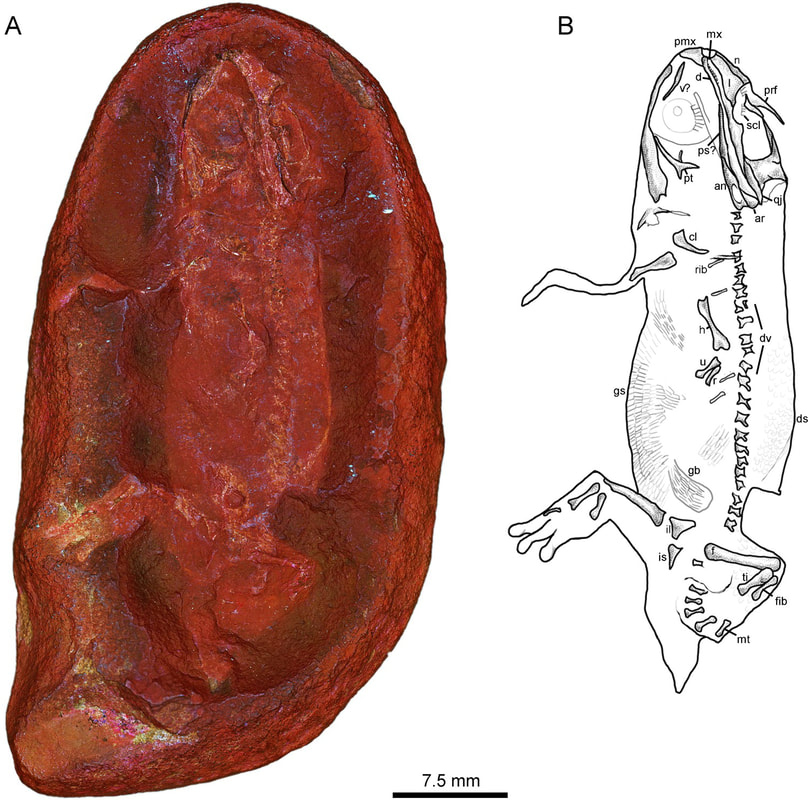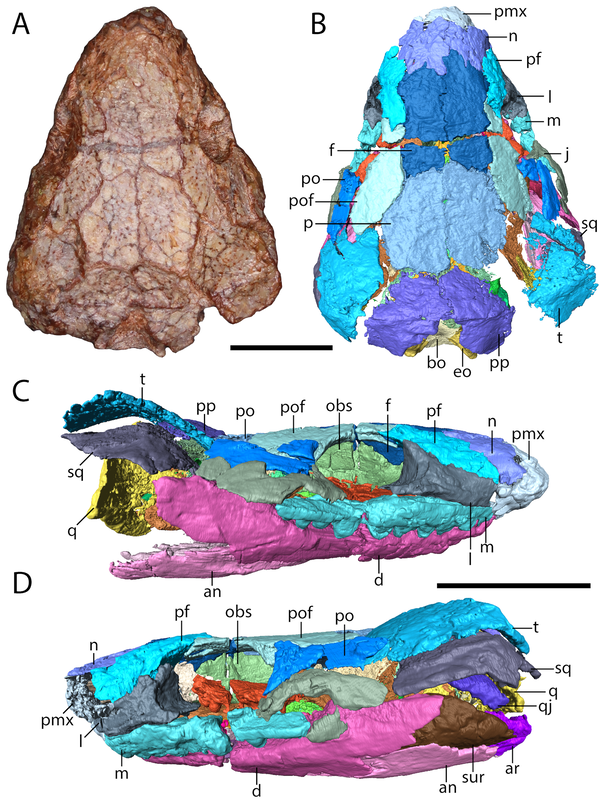|
Title: Lissamphibian-like toepads in an exceptionally preserved amphibamiform from Mazon Creek Authors: A. Mann; B.M. Gee Journal: Journal of Vertebrate Paleontology e1727490 DOI to paper: 10.1080/02724634.2019.1727490 Note: this paper came out on Wednesday, but it took a little while to get around to the blog post. As you can imagine, it's a little hard to write a blog in the middle of a pandemic. I actually plan to try to rev things back up in a week or two after I finish a bunch of problem sets for my stats classes, so stay tuned... General summary: Late Carboniferous Lagerstätte (fossil sites with remarkable preservation) are incredibly important for our understanding of the early evolution of many tetrapod clades. Mazon Creek in Illinois is one of the most famous Lagerstätte in North America and has produced a slew of both vertebrates and invertebrate material of great interest to paleontologists across the board (this is also where the famed Tully Monster comes from). The tetrapods have been studied by some of the most preeminent Paleozoic workers, including Moodie, Gregory, Watson, Westoll, Olson, and Baird, as well as by living paleontologists such as Jason Anderson and Andrew Milner. Preservation at Mazon Creek occurs in nodules that can be cracked in half to hopefully reveal a marvelous fossil within (or just a boring clay ball). Not only do these nodules often preserve complete, articulated skeletons, but they often preserve soft tissue structures (which is how we get a lot of records of squishy invertebrates). Here we describe a nice amphibamiform specimen (recalling that amphibamiforms are widely hypothesized to be on the lissamphibian stem) that preserves the oldest (quite possibly the only) record of toepad ('toe pad' with a space?) structures in a temnospondyl that superficially resemble those of lissamphibians. Arjan's doctoral dissertation is on Mazon Creek (the amniotes mostly); talk to him (arjanmann[at]cmail[dot]carleton[dot]ca) if you wanna know more about the exciting stuff going on!
Title: Computed tomographic analysis of the cranium of the early Permian recumbirostran 'microsaur' Euryodus dalyae reveals new information of the braincase and mandible. Authors: B.M. Gee, J.J. Bevitt, R.R. Reisz Journal: Papers in Palaeontology DOI to paper: 10.1002/spp2.1304
Title: Postcranial anatomy and histology of Seymouria, and the terrestriality of seymouriamorphs Authors: K.D. Bazzana; B.M. Gee; J.J. Bevitt; R.R. Reisz Journal: PeerJ vol. 8, article #8698 DOI to paper: 10.7717/peerj.8698 General summary: Back again with some more non-temnospondyl things (those are basically the rest of the papers I have coming out in the near future) on the amniote stem with Seymouria. The last paper led by Kayla looked at braincase anatomy based on some super neutron-CT datasets for Richards Spur material. This one is again looking at Seymouria from Richards Spur, but in the postcranial skeleton this time. Somewhat unusual for early Permian tetrapods, there is a substantial record of the postcranial skeleton for Seymouria based on fully articulated specimens from Germany and the redbeds of the southwest. However, most of the postcrania hasn't been described in great detail, and there's been very few records of postcrania from Richards Spur. This paper rectifies both of those to a degree, with description of really well-preserved isolated postcrania from the site that expands the osteology and knowledge of ontogenetic changes.
|
About the blogA blog on all things temnospondyl written by someone who spends too much time thinking about them. Covers all aspects of temnospondyl paleobiology and ongoing research (not just mine). Categories
All
Archives
January 2024
|


 RSS Feed
RSS Feed
